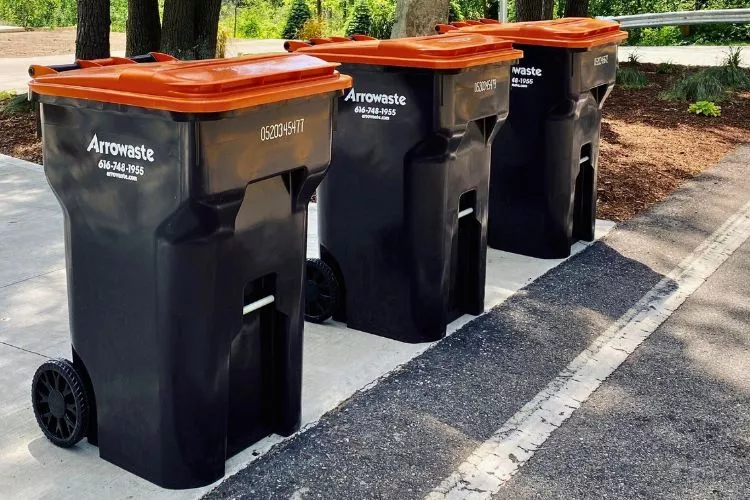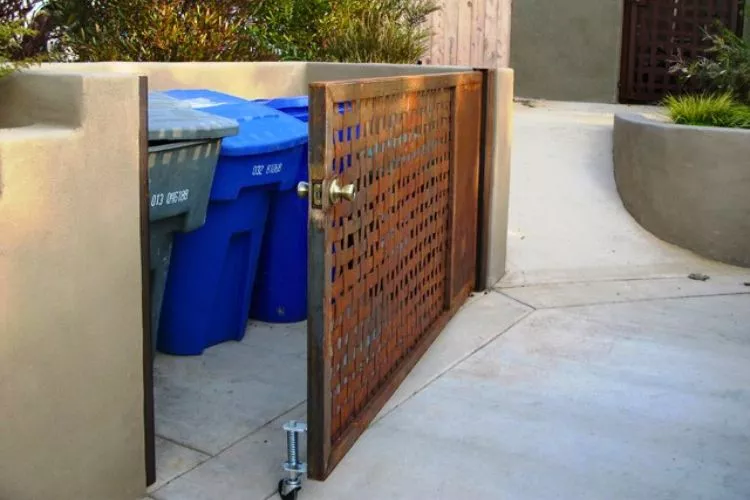Garbage cans are an indispensable part of our households, playing a crucial role in managing waste.
However, to ensure they do their job effectively without causing issues such as odors, spills, or attracting pest animals, it’s critical to keep them upright and secure.
Garbage cans toppling over can create unsightly messes, sometimes leading to frustrating cleanup situations.
In this article, we delve into practical strategies you can use to keep garbage cans from tipping over, ensuring a neat, well-organized waste disposal system at your home or business premises.

How to Keep Garbage Cans from Tipping Over?
By following these tips, you’ll be well on your way to maintaining garbage cans that are less prone to tipping over, resulting in a cleaner and more organized waste management system in your home or business.

Choose the Right Garbage Can
Selecting the appropriate garbage can is the first step in preventing tipping. Opt for cans with a sturdy, broader base to increase stability. You may also want to consider those with locking lids or straps to keep the lid secure and prevent wind or animals from knocking it over.
Additionally, go for cans made from durable materials, like thick plastic or metal, which will not only last longer but will also hold up well under various weather conditions.
Location, Location, Location
Place your garbage cans in sheltered areas like the side of your house or fence to limit exposure to wind and prevent them from rolling away.
Avoid placing garbage cans on inclined surfaces, as any gust of wind, animal activity, or slight bump could cause them to tip over. If possible, position the cans on a flat, stable surface such as a concrete pad, and avoid soft ground that may become unstable during rain.
Weight Distribution
Proper garbage placement within the can is crucial to prevent potential tipping. Distribute the weight of the trash evenly by placing heavier items at the bottom of the can and lighter items up top.
This will lower the center of gravity and reduce the risk of the can being toppled. Avoid overstuffing garbage cans, as a can too full and too top-heavy may easily be knocked over.
Secure the Can
Safeguard your garbage cans by anchoring them to a solid, immovable object like a post or wall. You may use bungee cords, rope, or chains to secure the cans in place, ensuring they remain upright and resist tipping or being blown away in high winds.
A can-holder, which is essentially a frame that cradles and stabilizes the can, can also help in keeping it secure and stable.
Additional Anti-Tipping Measures
Implementing some practical measures will further assist in keeping your garbage cans upright. If you live in an area prone to wildlife or roaming pets, consider investing in animal-resistant lids or containers that make it difficult for animals to access the contents of your garbage can.
Another tip is to place a few bricks or a bag of sand in the bottom of the garbage can, providing extra weight and stability to prevent it from being easily tipped over or moved.
Use a Can Caddy
Can caddies or dollies are designed to keep your trash cans secure and easy to move. They are usually equipped with wheels and have a slot to accommodate your trash can, effectively preventing it from toppling over.
Create DIY Storage
Building a small storage shed or a fenced area specifically for your garbage cans can help in preventing cans from tipping. It not only provides a sheltered place for the cans but also prevents them from being knocked over by strong winds or animals.
Weight at the Bottom
Instead of adding weights to the garbage, place them directly at the bottom of the bins when they are empty. These weights can be in the form of surplus bricks, rocks, or a bag of sand that will help stabilize the can.
Use Garbage Can Lids
Covers or lids for garbage cans are not only beneficial in containing the odor and keeping the garbage out of sight, but they can also help maintain the stability of the trash can, especially those with a locking mechanism.
Windproof Garbage Can Clips
These clips are designed to prevent the garbage can liners from slipping, which can cause the can to become imbalanced and tip over. These clips can be effortlessly attached along the edge of the can, securing the liner in place.
Remember, a combination of these methods will give you the best outcomes, ensuring your garbage cans remain upright and secure, contributing to a more efficient waste management system.
Where is the best place to put garbage cans?
Selecting the appropriate location for your garbage cans is not just crucial in preventing tipping and spillage, but it also affects accessibility, potential odors, and the overall aesthetics of your home or business premises. Here are some factors to consider when selecting the best place to put your garbage cans:

- Accessibility: Choose a spot that’s accessible for both you and the waste collection service. The path to reach it should be clear of obstacles that could hinder the movement of either the homeowners or the garbage truck.
- Away from windows or doors: To prevent any unpleasant smells from entering your home or business, position your garbage cans away from windows, doors, vents, and other openings.
- Sheltered Areas: Placing your garbage cans in a protected area, such as against the wall of a house or garage, can help shield them from wind. This not only helps avoid tipping but also prevents the cans from being moved around in heavy winds.
- Flat and Stable Surface: Ideally, garbage cans should be kept on a flat, solid surface like a concrete pavement or a pad made specifically for garbage cans. Placing cans on a soft ground could be problematic in rainy weather as the ground could become unstable and cause the cans to tip.
- Away From Rodents and Wildlife: If you live in an area with a lot of wildlife or have had problems with rodents, position your garbage cans in areas that aren’t easily accessible to these critters. This could be in a closed place like a shed or a storage room or using a garbage can enclosure or fencing.
- Aesthetics: While often overlooked, the visual aspect is vital too. If possible, position your garbage cans out of sight or consider using a garbage can screen or a storage shed to make them less visible and maintain the overall appeal of your property.
Remember to always ensure that the selected location adheres to your local waste collection regulations. The best spot is one that balances convenience, odor control, stability against tipping, and animal prevention while also keeping curb appeal in mind.
frequently asked question (FAQs)
What is Garbage Can Tie Downs?
Garbage can tie downs are anchoring systems designed to secure your garbage can to a firm structure, preventing them from tipping over, blowing away, or being knocked over by animals. These tie downs are often made from durable materials such as bungee cords, ropes, or chains and they typically attach to a wall, post, or sturdy fence. They offer a simple and effective solution to keep garbage cans stable, especially in areas prone to high winds or heavy animal activity.
What is Garbage Can Weights?
Garbage can weights are heavy objects that are used to add stability and prevent garbage cans from tipping over. They can be strategically placed at the bottom of an empty bin to lower the center of gravity. The weights could be commercial products crafted specifically for this purpose, or household items like bricks, large rocks, or sandbags. By placing these weights at the bottom, you create a more grounded and stable garbage can that’s less likely to be knocked over by wind, animals, or accidental bumps.
What is a Windproof Garbage Can?
A windproof garbage can is a specially designed trash bin that reduces the likelihood of tipping over or being blown away in high winds. These cans often have a broad, heavy base that lowers the center of gravity, enhancing stability. Some windproof cans come with secure locking lids that prevent contents from being scattered by the wind. Features such as sturdy materials, unique shapes, and built-in wind-resistance mechanisms like clips or locks also contribute to making a garbage can windproof.
Conclusion:
Maintaining your garbage cans’ stability is critical to efficient waste management and preventing unnecessary, messy situations. By opting for sturdy, well-designed garbage cans and ensuring they’re placed on flat, sheltered surfaces, you can significantly reduce the chances of tipping.
Furthermore, implementing strategies such as even weight distribution, anchoring cans to stable structures, or adding extra weight to the can’s base can also offer substantial protection against toppling.
By following these practical and straightforward suggestions, you can keep your garbage cans upright, contributing to a more organized and cleaner living space.


